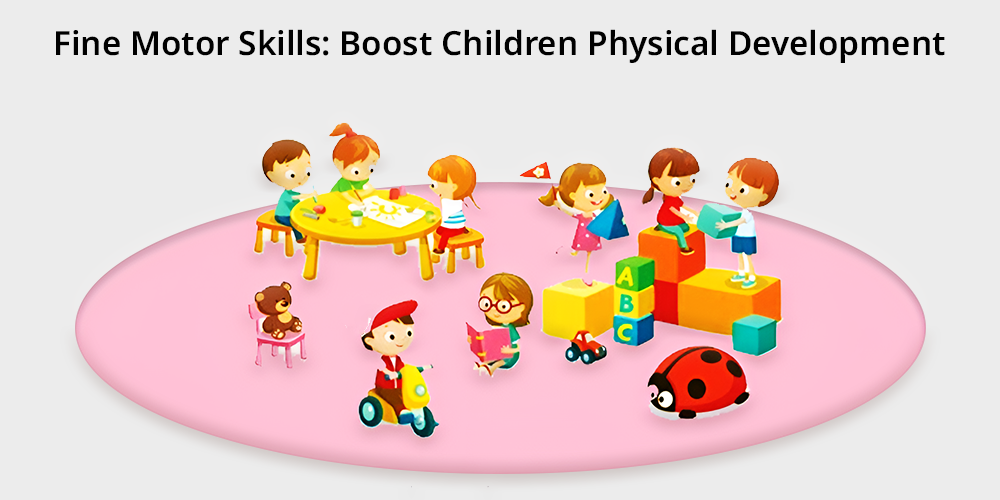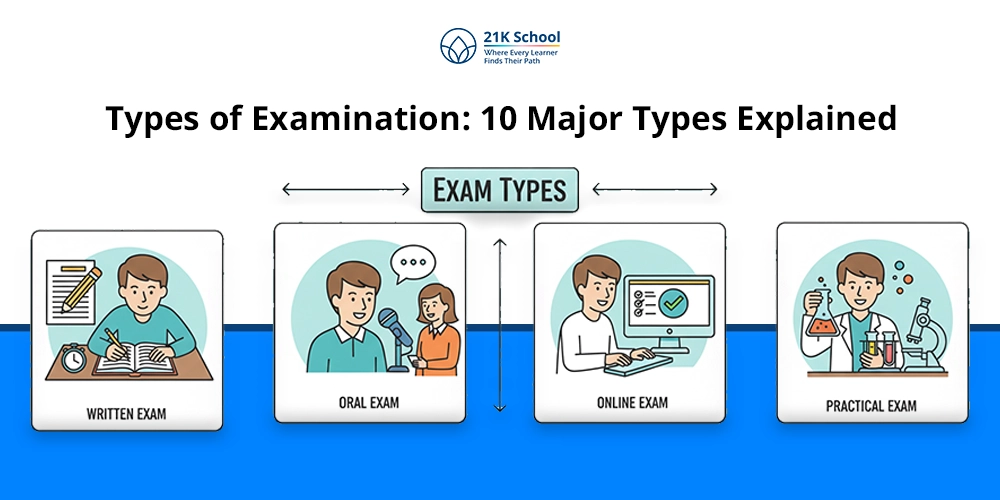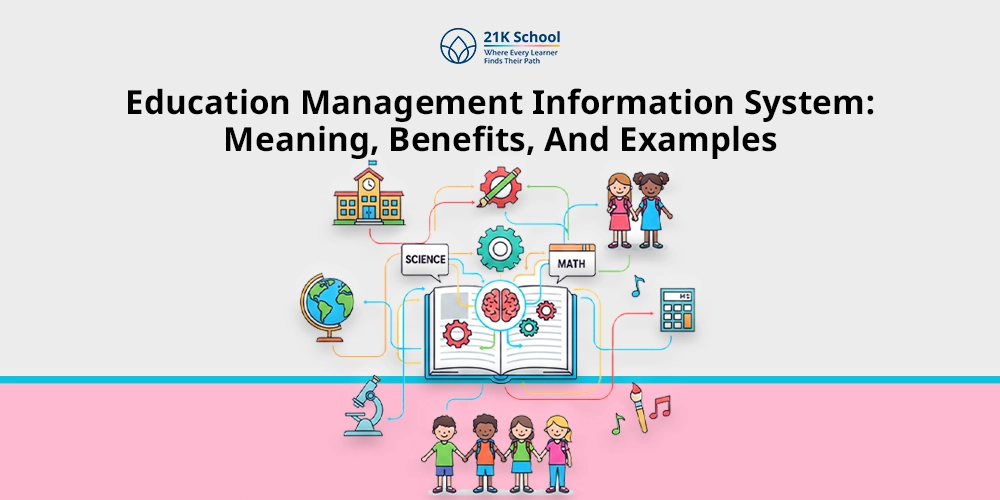
Have you ever watched kids struggling to tie their shoe laces or grip a crayon for the first time?
If yes, let me tell you these small everyday activities such as feeding themselves through a toy or drawing a smiley face are cute gestures.
These milestones are part of something bigger and crucial which is: Fine Motor Skills Development in Kids.
Fine motor skills refers to the ability to use small muscles, especially in the hands and fingers, for precise and coordinated movements.
In this blog we will take you in the journey of understanding everything about fine motor skills. From achieving milestones to simple activities.
Each step you read makes a big difference in kids’ lives. Are you ready to give a strong start with fine motor skills?
Contents
- What Are Fine Motor Skills?
- Importance of Fine Motor Skills in Early Years
- Fine Motor Skills Milestones for Children
- How Do You Develop Fine Motor Skills?
- Activities to Enhance Fine Motor Skills in Kids
- Signs of Delayed Fine Motor Development
- Difference Between Fine Motor Skills and Gross Motor Skills
- Final Thoughts: Beneficial Long-term Skill Development
What Are Fine Motor Skills?
In simple words, fine motor skills involve the coordination of small muscles in the hands, fingers, and wrists for accurate movements.
These skills allow kids to perform tasks such as:
- Holding a pencil
- Peeling Stickers
- Buttoning clothes
- Cutting with scissors
- Feeding themselves with a spoon
- Lacing and Threading
- Pickup sticks
These skills are necessary for everyday activities of children which include self-care, learning, and work. With time and practice students can get benefits of fine motor skills.
Unlike gross motor skills in which large muscle groups involve significant movements such as walking, running or jumping.
Fine motor skills mainly focus on precision and control. These skills are ideal for everyone from infants to young kids.
It works as a foundation of academic achievement and personal development. Let’s understand the importance of fine motor skills in kids’ lives.
Importance of Fine Motor Skills in Early Years
In early years of development fine motor skills are significant. It impacts kids’ abilities to learn, interact, and thrive in various aspects of life.
There are various reasons for developing fine motor skills in early childhood. For example: fostering kids independence, enhancing cognitive development, and preparing children for school and life tasks.
1. Independence and Self-Care
Fine motor skills are essential for each kid. It impacts a child’s ability to perform everyday tasks, fostering independence, and building self-esteem.
Self care tasks such as combing, dressing, eating, writing, and playing.
2. Hand-Eye Coordination
In the early stage fine motor skills development of strong hand-eye coordination lays a foundation for future success in various domains, from academics to physical activities.
These skills include coordination of visual perception with physical movement. For example choosing the right colour for creating paintings ideas.
3. Brain Development
Fine motor skills are fundamental for a child’s growth and learning. It helps in children’s mental health development from a small age.
Students are engaged in different activities to improve their academic performance with time.
To improve kids brain development read fun mental health activities for kids growths.
4. Preparation for Future Tasks
Fine motor skills are important for child development because it helps in the preparation for future tasks.
These skills engage children for activities like writing, drawing, and using everyday tools. This leads to academic success and daily life tasks.
5. Cognitive Development
Fine motor skills help in cognitive development of kids by improving learning ability and memory.
It is also linked to the improvement of other cognitive development, such as hand-eye coordination, problem-solving, and spatial awareness.
Fine Motor Skills Milestones for Children
Fine motor skills activities for infants and toddlers to build a strong presence. Achieving these milestones will impact kids’ lives.
It guides parents and teachers to teach everyday growth and development. They also recognized the challenges kids are facing and found solutions.
Here you can go through a list of fine motor skills children should do when they are between zero to two years old.
- Zero to 6 months
- Reflexive grasping of objects placed in hand done by babies in zero to two months.
- Bringing hands to mouth intentionally in three to four months.
- Beginning to reach for toys by coordinating with hand eye in four to six months.
- Holding rattles or soft toys with their thumb and index finger.
- 6 months to 1 years
- Kids pick up small items with their thumb and forefinger or pincer grasp.
- Toddlers improve their fine motor skills to grasp and manipulate objects, and they start scribbling. Kids transferring objects from one hand to the other.
- Kids banging objects together at one place.
- They start exploring different textures and objects with fingers to know more.
- 1 to 2 year
- In this phase the stacking a few blocks or making towers.
- Start scribbling with crayon in different places.
- Try to turn pages in a book or multiple pages at a time to explore new things.
- Using a spoon with elder assistance.
- 2 to 5 years
- Drawing shapes and basic people to become familiar with now items.
- Paper cutting and tearing with scissors. Remember to start with simple snips.
- Completing simple and age appropriate puzzles to engage kids of 2 to 5 years.
- Buttoning, zipping, and using utensils more accurately.
- Building block towers and complex structures more precisely than before.
- 5 to 8 years
- 5 to 6 years old children begin to learn to write and print letters and numbers.
- Kids in the age of 6 to 7 years improve their handwriting and learn to use a variety of tools such as pen pencils etc.
- 7 to 8 years old kids have fine motor coordination, allowing them to tackle more complex tasks. These tasks include advanced building blocks and dressup for school.
How Do You Develop Fine Motor Skills?
Fine motor skills development needs time; the process goes gradually supported by engaging and age-appropriate activities. Now you can understand everything.
To develop these skills engage children in activities that require the use of small muscles in the hands and fingers like, cutting, and drawing.
Lets see some common activities to learn fine motor skills in kids:
1. Playing with Playdough or Clay
Playing with playdough or clay is an ideal way to develop fine motor skills in childrens. It includes squishing, pinching, and using different tools.
These activities encourage the use of small muscles in the hands and fingers, strengthening them and improving dexterity.
2. Cutting and Pasting
One of the popular ways to start developing fine motor skills is cutting and pasting. With the help of scissors kids cut the stickers and paste in the desired place.
This will improve hand-eye coordination, strengthen hand and finger muscles, and enhance pincer grip.
3. Household Tasks
Household tasks are valuable fine motor skills which ensure multi tasking and engaging activities. It improves coordination and strength.
Engaging in household activities like using utensils, opening and closing containers, arranging boxes, counting vegetables, identifying fruit colors etc are ideal.
4. Using Tweezers or Tongs
With the help of tweezers or tongs develop fine motor skills by strengthening hand and finger muscles.
It improves kids’ hand-eye coordination, and enhances precision and control.
Activities to Enhance Fine Motor Skills in Kids
In the given list the points are an elaborated and detailed version of each fine motor skills activity which helps parents and teachers to guide kids.
Remember each activity is different and implement them based on the kid’s age and needs.
Some of these skills perform individually and others are group activities which also improve communication skills and engagement between kids.
1. Drawing and Painting
Drawing and painting in fine motor skills refers to precise hand and finger movements to manipulate tools like crayons, paintbrushes, and scissors.
Advantages of this fine motor skill:
- Grip Practice: When kids hold crayons, markers, pencils, or paintbrushes it impacts on strengthens fingers and refines grip.
- Controlled Movements: This fine motor skills encourages child’s hand control, necessary for writing and intricate tasks.
- Creativity and Focus: With the help of drawing and painting children plan and execute visual ideas, improving attention span.
2. Playing with Blocks and Building Toys
Playing with blocks and building toys will boost dexterity, hand-eye coordination, spatial awareness, and problem solving abilities in kids.
Advantages of this fine motor skill:
- Hand Strength and Dexterity: Childrens place and connect pieces which improves the control and stability in hand muscles.
- Hand-Eye Coordination: By aligning and stacking pieces helps in training visual-motor integration of kids.
- Problem-Solving Skills: Designing structures encourages planning, sequencing, and spatial reasoning.
3. Sorting Coins
Sorting coins is a fine motor activity in which kids pick up and manipulate coins to sort them by size, color, or other attributes.
It directly develops hand and finger strength, hand-eye coordination, and problem-solving skills in kids.
Advantages of this fine motor skill:
- Pincer Grasp: Kids pick up small coins which strengthens their thumb and forefinger coordination with time.
- Tactile Discrimination: By learning differentiating sizes, textures, and edges of coins, teachers can introduce new things which boosts sensory processing.
- Counting and Classifying: Supports early math skills while developing motor precision.
4. Using Utensils
Using utensils in fine motor skill development means eating, painting, or playing with toys.
This activity helps children in coordination, discipline and allows them to control movements.
Advantages of this fine motor skill:
- Wrist and Finger Strength: If kids manage utensils in daily activities it trains their muscles for more refined movements.
- Self-Care Skills: Most fine motor skills promote independence and practical life readiness of students.
- Crossing Midline: Reaching across the body with a utensil enhances bilateral coordination.
5. Buttoning and Zipping Clothing
Buttoning and zipping clothing is a regular practice kids perform in their daily lives.
This activity encourages childrens to dress and undress independently, promoting finger strength and fine motor coordination.
Advantages of this fine motor skill:
- Bilateral Coordination: From a young age both hands must work together and equally. For example if one stabilises and one moves.
- Sequencing: Understanding the steps of fastening boosts cognitive and motor planning.
- Fingertip Strength: Manipulating shirt buttons and zippers will help kids in strengthening tiny hand muscles on a daily basis.
6. Playing with playdough
To improve hand-eye coordination and dexterity playing with dough is an ideal fine motor skill.
In this activity kids squeeze, pinching, and pulling the dough which is also relaxing and releases stress or tension.
Advantages of this fine motor skill:
- Muscle Building: Squeezing, rolling, and shaping the dough directly enhances the kid’s hand and finger strength.
- Tactile Sensory Input: By using different textures students can work with sensory exploration and tolerance.
- Tool Use: To make it interesting kids can use tools such as rollers, cutters, molds. This will improve coordination and precision.
7. Stringing beads or pasta
Stringing beads or pasta means making different kinds of pasta such as penne, rigatoni, or macaroni.
It needs precision which improves fine motor skills in kids. Try out new shapes for creativity.
Advantages of this fine motor skill:
- Pincer Grasp Development: Students can start with pinching beads which train the thumb and index finger.
- Visual-Motor Skills: To improve visual motor skills, aligning the string with the bead hole strengthens eye-hand coordination.
- Concentration and Patience: This activity improves focus that helps in concentration in exam stress.
8. Ripping and Tearing Paper
Ripping and tearing paper is one of the best fine motor skills for kids. The activity helps in muscle strengthening especially in hands and fingers.
To enhance kids’ gripping power parents and teachers can use ripping and tearing paper fine motor skills.
Advantages of this fine motor skill:
- Hand Separation: The activity teaches one hand to work while the other stabilizes.
- Bilateral Coordination: Ripping and paper tearing requires both hands to perform different tasks simultaneously. Learn more about paper tearing activities.
- Precision and Tracking: Following lines or shapes helps with visual tracking and muscle memory.
8. Cutting with Scissors
Cutting with scissors means kids use tools like scissors to make creative shapes or any decorative items.
This activity helps to incorporate concentration and creative thinking skills among children. School art and craft period is an ideal example.
Advantages of this fine motor skill:
- Hand Separation: It also ensures one hand to work while the other stabilizes.
- Bilateral Coordination: This motor skill improves bilateral coordination and requires both hands to perform different tasks simultaneously.
Signs of Delayed Fine Motor Development
Each child is different, so has their development. Growing at their own pace parents and teachers can see signs of delaying five motor developments.
These indicators create difficulty with tasks requiring small muscle coordination, like grasping objects, holding pencils, or using utensils.
Lets elaborate each point in depth:
1. Difficulty with Grasping and Manipulating
Difficulty in grasping and manipulating means children are getting problems in picking up tools on materials such as crayon toys or any other object.
This will affect the ability to use small muscles in the hands, fingers and difficulty in performing everyday tasks.
2. Writing and Drawing Difficulties
Fine motor skills have a direct impact on writing and drawing. Sometimes kids feel difficulty to draw or write properly even when they are at an appropriate age.
This ensures that parents need to visit the nearby doctor for consultation on how to improve fine motor skills.
3. Clothing and Grooming Challenges
Fine motor skills challenges with clothing and grooming include being unable to dressup, buttoning shirts or zipping zippers etc.
If kids are unable to do these small tanks then it impacts their independence and overall development.
3. Messy Work
Delay in fine motor skills leads to messy work which includes difficulties in tasks like coloring, using glue, or making creative painting.
Various art and craft ideas for kids are helpful for improving creative thinking skills and the development of kids. Delay leads to unusual struggles especially when moving.
Difference Between Fine Motor Skills and Gross Motor Skills
Exploring the difference between fine and gross motor skills is important for a holistic view of kids’ physical and mental developments.
Here’s differentiating table to understand in better way:
| Sr. No. | Particulars | Fine Motor Skills | Gross Motor Skills |
| 1. | Meaning | Fine Motor Skills refers to the movement of small muscles using hands and fingers. | Gross Motor Skills refers to the larger muscle groups and whole-body movement. |
| 2. | Example | Some common examples of fine motor skills are writing, cutting with scissors, typing, using a fork, buttoning a shirt, tying shoelaces, turning door knobs, dialing a phone etc. | Some common examples of gross motor skills are running, jumping, skipping, climbing, throwing, kicking, balancing etc. |
| 3. | Importance | Fine motor skills facilitate self-care tasks, creative expression, and the use of technology. | Gross motor skills develop coordination, balance, and overall body strength. |
| 4. | Amount of Space Needed | Gross motor skills activities mostly need large space as compared to fine motor skills activities. These big moments need a lot of space and freedom to move anywhere. | Fine motor skills mainly focus on small moments of hand and fingers which leads to small or indoor places. Children can choose a comfortable environment without thinking about big or open space. |
| 5. | Development Timeline | Gross motor skills Develops earlier in infancy. For example crawling, standing, walking. | Fine motor skills develop gradually after basic gross motor skills are established. |
Both types of motor skills are interlinked and go hand in hand. As per research both fine and gross motor skills are equally important for kids’ development.
Activities like climbing and catching a ball contribute to overall coordination, balance, and strength, which indirectly support fine motor development as well.
To know more about fine more skill activities and gross motor skill activity visit the 21K school blogs section.
Final Thoughts: Beneficial Long-term Skill Development
From years fine motor skills plays a significant role in a child’s early years. It continues to improve kids’ lives.
From academic performance, social confidence, to independence throughout their life. By understanding these milestones, elders can guide students to achieve growth.
Fine motor skills offer fun activities for kids. However, parents need to monitor the signs of delay and ensure children build strong foundations in learning and development.
Investing time and effort into nurturing fine motor skills sets the stage for success in school and beyond.
Whether it’s writing or painting, or simply buttoning the shirt, the seemingly simple activities are powerful solutions for a child’s growth and development.



